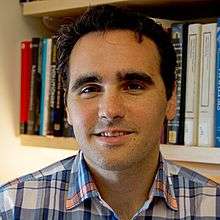Damon Centola
| Damon Centola | |
|---|---|
 Prof. Centola | |
| Born | July 19, 1973, Philadelphia, Pennsylvania, U.S. |
| Occupation | Professor |
| Institutions | University of Pennsylvania, MIT, Harvard University, Stanford University |
| Alma mater | Cornell University (Ph.D.) (M.A.), Tufts University (M.A.), Marlboro College (B.A.) |
| Fields | Agent based modeling, web-based experiments (Internet experiments), complex contagions, social networks, social epidemiology |
| Known for | Complex contagions |
| Website | http://ndg.asc.upenn.edu/ |
Damon Centola is an Associate Professor in the Annenberg School for Communication and the School of Engineering and Applied Sciences at the University of Pennsylvania,[1] where he is Director of the Network Dynamics Group.[2] Previously, he was an Assistant Professor at M.I.T. Sloan School of Management (2008-2013).[3] He was also a Robert Wood Johnson Fellow at Harvard University,[4] a member of Sci Foo Campers community, and a fellow of the Center for Advanced Study in the Behavioral Sciences at Stanford University.[5]
Centola's research focuses on the study of social networks, social epidemiology, and web-based experiments on diffusion and cultural evolution.[6][7][8][9][10]
Popular accounts of Damon’s work have appeared in mainstream media publications such as The New York Times,[11] The Washington Post,[12] Wired,[13] TIME,[14] CBS,[15] and CNN.[16] His research has been funded by the Robert Wood Johnson Foundation, the National Science Foundation, the National Institutes of Health, the James S. McDonnell Foundation, and the Hewlett Foundation. He is a series editor for Princeton University Press.[17]
Career
Centola is best known for his work on complex contagions, which was the topic of his Ph.D. dissertation in Sociology, supervised by Michael Macy at Cornell University. After completing his doctorate degree at Cornell, Damon spent two years as a Robert Wood Johnson Postdoctoral Fellow in Health Policy at Harvard University. He then joined the faculty of the Sloan School of Management at MIT in 2008.[18] In 2013, he moved to the University of Pennsylvania's Annenberg School for Communications.
Complex Contagions
Centola and Macy found that information and disease spread as “simple contagions,” requiring only one contact for transmission, while behaviors typically spread as “complex contagions,” requiring multiples sources of reinforcement to induce adoption. Centola’s work builds on Granovetter’s work on the strength of weak ties and threshold models of collective behavior, as well as Duncan Watts and Steve Strogatz’s work on small world networks. Centola and Macy show that the weak ties and small worlds networks are both very good for spreading simple contagions. However, for complex contagions, weak ties and small worlds can slow diffusion.[19]
Awards
Damon Centola received the American Sociological Association’s (ASA) Award for Outstanding Article in Mathematical Sociology in 2006, 2009, and 2011,[20] and was awarded the ASA's 2011 Goodman Prize for Outstanding Contributions to Sociological Methodology.[21] He was a developer of the NetLogo agent based modeling environment,[22] and was awarded a U.S. Patent for inventing a method to promote diffusion in online networks.[23]
References
- ↑ University of Pennsylvania https://www.asc.upenn.edu/people/faculty/damon-centola-phd Retrieved November 7, 2016
- ↑ Network Dynamics Group http://ndg.asc.upenn.edu/ Retrieved November 5, 2017
- ↑ Peter Dizikes, MIT News Office "Better health through social networking" MIT News. Retrieved September 3, 2010
- ↑ RWJ Scholars in Health Policy Research Program, Harvard University http://www.rwj.harvard.edu/harvardscholars.html Retrieved November 5, 2016
- ↑ CASBS Names 2014-15 Class of Fellows Center for Advanced Study in the Behavioral Sciences at Stanford University. Retrieved April 30, 2014.
- ↑ Centola, D. (2010) "The Spread of Behavior in an Online Social Network Experiment." Science Vol. 329, Issue 5996, pp. 1194-1197; DOI: 10.1126/science.1185231
- ↑ Centola, D. (2011) "An Experimental Study of Homophily in the Adoption of Health Behavior" Science 02 Dec 2011: Vol. 334, Issue 6060, pp. 1269-1272; DOI: 10.1126/science.1207055.
- ↑ Centola, D.; Baronchelli, A. (2014) The Spontaneous Emergence of Conventions: An Experimental Study of Cultural Evolution PNAS vol. 112 no. 7; 1989–1994, doi: 10.1073/pnas.1418838112.
- ↑ Centola, D. (2015) The Social Origins of Networks and Diffusion American Journal of Sociology. Vol. 120, No. 5 (March 2015), pp. 1295-1338. DOI: 10.1086/681275 Stable URL: http://www.jstor.org/stable/10.1086/681275.
- ↑ Centola, D. (2012) A Simple Model of Stability in Critical Mass Dynamics Journal of Statistical Physics. J Stat Phys DOI 10.1007/s10955-012-0679-3
- ↑ Natasha Singer. "Better Health, With a Little Help From Our Friends" The New York Times. Retrieved September 18, 2010
- ↑ Meeri Kim. "Why everyone started naming their kids Madison instead of Jennifer" The Washington Post. Retrieved Feb 7, 2015.
- ↑ Jess McNally. "Cluster Networks Spread Behavior Change Faster" WIRED. Retrieved September 2, 2010.
- ↑ Mandy Oaklander. "Science Says This Is the Best Motivation to Exercise" TIME. Retrieved November 1, 2016.
- ↑ Mary Brophy Marcus. "Need motivation to exercise? Try a little healthy competition" CBS News. Retrieved October 31, 2016.
- ↑ Elizabeth Landau. "Similar friends may spread healthy behaviors" CNN. Retrieved December 2, 2011.
- ↑ Center for the Study of Social Organization Princeton University. Retrieved October 3, 2016
- ↑ MIT News Office "Public-health networks." YouTube Retrieved November 07, 2016.
- ↑ Centola, D.; Macy, M (2007) "Complex Contagions and the Weakness of Long Ties." AJS Volume 113 Number 3 (November 2007): 702–34.
- ↑ Section on Mathematical Sociology Outstanding Publication Award American Sociological Association. Retrieved November 4, 2017.
- ↑ The Section on Methodology's Leo Goodman Award American Sociological Association. Retrieved November 3, 2017.
- ↑ NetLogo Models Library: Sample Models/Social Science NetLogo. Retrieved November 6, 2016
- ↑ Centola, et al United States Patent and Trademark Office Family ID: 39888340; App. Number: 11/809,328; Filed: May 31, 2007. Retrieved November 6, 2016.